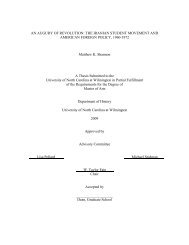HIERARCHAL INDUCTIVE PROCESS MODELING AND ANALYSIS ...
HIERARCHAL INDUCTIVE PROCESS MODELING AND ANALYSIS ...
HIERARCHAL INDUCTIVE PROCESS MODELING AND ANALYSIS ...
You also want an ePaper? Increase the reach of your titles
YUMPU automatically turns print PDFs into web optimized ePapers that Google loves.
specifying the space of possible equations and a dependent variable and will output<br />
the best equation for the variable, able to only perform the search for one variable<br />
at the time (Dzeroski et al. 1993, Todrovski 2003). This is further related to the<br />
methods used in Ljungs work (1993) on system identification, but is further removed<br />
to that of inductive process modeling.<br />
The main assumption behind system identification is that the model structure<br />
is known and that the primary concern is finding the adequate parameter values;<br />
equation discovery focuses on both the structure and parameter values (Todorovski<br />
et al. 1998). Both of these approach produce descriptive models that summarize<br />
and predict the data but they fail to search through the space of alternative explanations,<br />
these methods do not take into account models with theoretical variables<br />
or consider alternate processes to explain certain dynamics (Bridewell et al. 2005).<br />
The Southern Ocean covers an area equivalent to about 10% of the global ocean<br />
and is a key element of the global ocean system as it links all major ocean basins and<br />
facilitates the global distribution of its deep water; it is considered to play an important<br />
part in the global carbon (C) cycle (Arrigo et al. 2003). The Ross Sea polynya<br />
(area of open water surrounded by sea ice) is one of the most productive ecosystems<br />
in the Southern Ocean as it experiences some of the largest phytoplankton blooms<br />
in the region (Arrigo et al 1994, 1998, 2000, 2003). Indeed, phytoplankton productivity<br />
(photosynthesis) is important to the carbon cycle as it removes carbon dioxide<br />
(CO 2 ) from surface water during photosynthesis, part of which will then be exported<br />
to deep ocean water. What makes the Ross Sea polynya so interesting for ecologist<br />
compared to other locations such as Terra Nova Bay, is the type of phytoplankton<br />
dominating the ecosystem. In the Ross Sea polynya , Phaeocystis antartica dominates<br />
as opposed to diatoms (species such as Fragilariopsis spp.) in Terra Nova Bay.<br />
Phaeocystis antartica are thought to resist grazing more than other phytoplankton<br />
species, which could imply that more carbon would be taken from shallow water into<br />
6
















